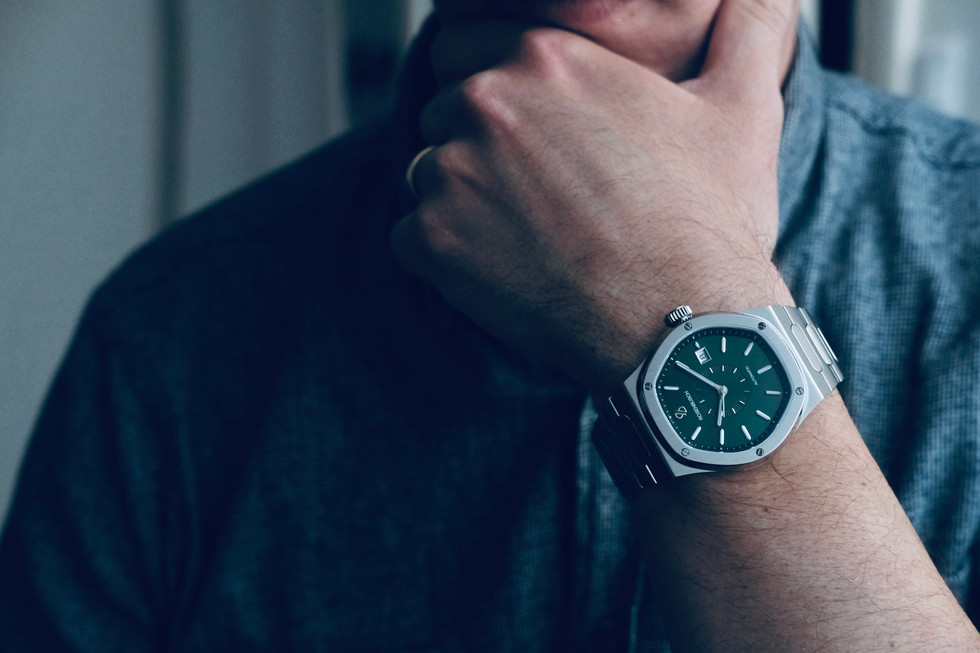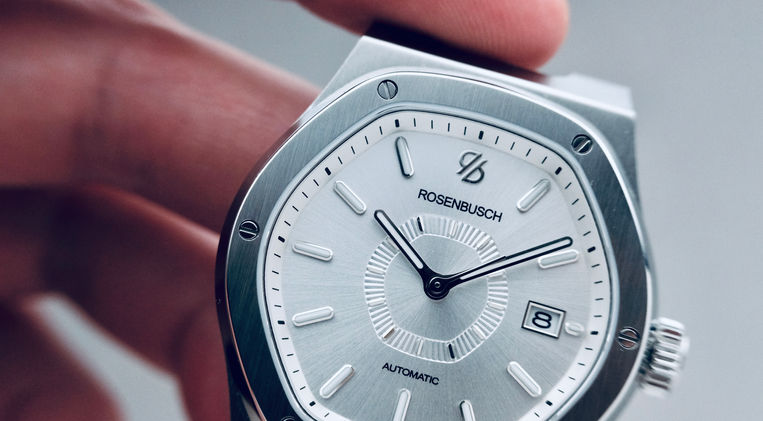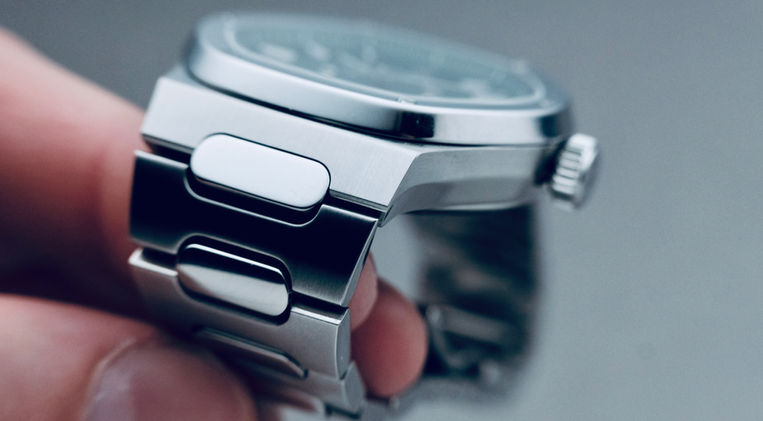top of page
Rosenbusch Quest
This Is Affordable Luxury
If there is one genre of watches that will never get old—or better said, go out of fashion—are sport watches with integrated bracelets. There is something unique about the fact that the bracelet flows out of the case in such a natural and effortless way that continues to win over the hearts of many collectors and enthusiasts. For some, this type of watch is quintessential and could constitute anyone’s one-watch collection timepiece. Because in general they are well-built, elegant, and versatile. Think Audemars Piguet’s Royal Oak, Patek Philippe’s Nautilus, IWC’s Ingenieur, and Vacheron Constantin’s 222. Given who was there first, it seems hard—if not impossible—for any brand to make their own version of a sports watch with an integrated bracelet. What’s difficult is to not make it look like a Royal Oak or a Nautilus. Or an Ingenieur. Or a 222.
If a brand, therefore, dares to launch themselves in the saturated market of independent horology with such a model, they must either be insane or find a way to circumvent the direct association of “making another Genta homage.” In my humble opinion, the latter is often true although the former is almost always a given. In any case, you’re in luck today because we’re going to take a look at the first model from a new brand—a sports watch with an integrated bracelet—imbued with authenticity and quality. Indeed, the Rosenbusch Quest is the newest and greatest of this genre of watch. Making this happen, however, cannot be easy and it takes a certain type of entrepreneur/designer to make it a reality. Which is what we’re going to discuss later in the review. But first, let’s talk about the good stuff: the specifications.

Specifications
Watches that have an integrated bracelet design often come with a multifaceted fixed bezel. They generally come with eight or 12 sides that all have the same length and frame the dial in a unique way. The Quest comes with six sides, however they do not all have the same length. This is something that is most apparent when looking at the watch from different angles as the light catches each side in different ways. (And I hope the photos will demonstrate what I’m talking about here.) Honestly, the Quest is not necessarily for those who have tiny wrists given its 42mm case diameter, 49mm lug-to-lug, and 11.7mm thickness. However, it does command a strong presence which is something the brand owners were not trying to avoid. (This comment will make more sense later.)
As mentioned in the introduction, watch enthusiasts and collectors often gravitate toward this type of timepiece because they are versatile. Both in terms of how they look and how they are built. In other words, the Quest is an everyday watch and it was made to be this way. To fulfill its destiny, the Quest comes with some key specifications: a solid Swiss made Sellita SW200 Élaboré* (4Hz/38 hours of power reserve,) 100 meters of water resistance thanks to a screw-down crown and case-back, a sapphire crystal, SuperLuminova, and a well-machined bracelet complete with butterfly clasp. In other words, you get all of what you need from a watch meant to be worn daily. And although we will talk more about design below, it should be noted again that the Quest would easily look the part in many situations we commonly find ourselves in.
*The Quest will also be offered with a Seiko NH35 movement for a lower price.
From a finishing standpoint, we find mirror-like polished surfaces on the sides of the bezel, the lower section of the mid-case, as well as on the sloped edges of the case-back and the center links of the bracelet. Satin brushed surfaces everywhere else and in the most crucial areas. For example, on the top section on the mid-case that is more prone to being in contact with hard surfaces (the bane of stainless steel!) and the top sections of the bezel and lugs. Given the Quest’ proportions, one must welcome this intense alternation of finishes which highlight the geometrical nature of the case design. And, I would add, having these two types of finishes and seeing them where they are, aids in giving the Quest an everyday-watch vibe that many of us enthusiasts are looking for.

Design
Besides the specs, the Quest is a watch that shines through its design. As we now know, making a sports watch with an integrated bracelet is no small feat. And it’s ballsy. So in order to get our attention and to stand apart from other similarly-shaped watches, Rosenbusch had to give it all in the design department. The first element that jumps out to me is the hexagonal dial which perfectly integrates within the hexagonal shape of the bezel. The minute track printed on the sloped rehaut appears to be a continuation of the sloped and rounded edges of the outside of the bezel. It looks as if the bezel + rehaut combination is a mountain range that encircles and protects the dial. This layout also makes it possible to maximize the dial opening and to keep the latter legible.
Have you noticed the hexagonal seconds track at the center of the dial? And the texture it comes with, resembling that of a coin-edged bezel? Whatever it is supposed to look like, it does a great job at highlighting the seconds track unusually placed in this way. The seconds hand, therefore, is short to match the small seconds track, and it doesn’t come with a counter-balance. (A fact that makes sense given how short it is.) The long hour and minute hands are rounded batons of which design matches that of the applied—and almost oblong—hour markers. The hour markers have polished surround which make them stand out from the dial. The Quest is, in other words, a legible timepiece, something that any everyday watch should be.
Lastly, the Rosenbusch logo is polished and takes the spot of the marker at the 12, and there are only two words printed on the dial: “Rosenbusch” below the logo and “Automatic” above the 6. Being made for everyday use, the Quest comes with a date aperture at the 3 which is framed. As you can see, Rosenbusch paid close attention to making the Quest symmetrical and balanced, to the point of ensuring that the Genta-like screws on the bezel are aligned at each corner. (Some screws on my photos are not aligned because the watches I received are prototypes. This will be remedied on the production models.)

At Heart of the Matter
At the heart of the matter is the fact that Rosenbusch managed to make yet another integrated bracelet sport watch that looks interesting and different. Imagine the horror if all dive watches had Mercedes hands and the same bezel font as the Rolex Submariner, or if each chronograph had the ultra symmetrical dial layout of an Omega Speedmaster? This could have easily been the case if it were not for the dedication and drive of those who design the mechanical objects that we love to strap on our wrists everyday. Earlier in the article I mentioned that Rosenbusch didn’t avoid making a larger watch and this for a good reason: to them, someone who sports a watch like the Quest is not afraid of making a statement. So why make it small?
Go big or go home.
This approach is as daring as the one of designing an integrated bracelet sport watch in the first place. We’ve seen many of those before, and although some would criticize any brand trying to make their own version of it—as if it was forbidden because it has been done before—I would say this: revisiting iconic designs from a new perspective is a healthy process for horology. It keeps the market alive and dynamic. Not doing so would be akin to not upgrading how the clothes we wear everyday look like, or if all cars looked the same as they did in the 1970s. Denying a brand the right to make a sports watch with an hexagonal fixed bezel because it has been done before would just be as silly as saying only Rolex can make dive watches. (Actually, that would be Blancpain.)
At the end of the day, and setting aside how the Quest looks and how it is built, it is, at its core, a potential one-watch collection timepiece. At the very least, it does all of what this type of watch should do: telling the time effortlessly, being practical (referring here to the date complication,) and being versatile to work in many, if not all, situations we find ourselves in. (And here I’m talking about us regular humans who don’t spend their time traveling to far-flung places on earth to capture Instagram-worthy shots.) Because just like a Royal Oak or 222 could be someone’s everyday watch, the Quest could be one as well for you. The huge advantage the Rosenbusch has over the others is its asking price: from roughly $500 to $1,067 (more details below.)
In other words, most of us, if not everyone, can afford a high-quality German-made Quest.

Conclusion
I have a confession to make: I didn’t care for watches that have an integrated bracelet before I started reviewing them last year. The Quest is the third that I got my hands on and I now understand what makes them timeless. They have a bit of everything that we need in an everyday timepiece and none of what doesn’t matter. It doesn’t have complications we rarely use or precious metal hour marker surrounds we know would attract the wrong type of attention on the street. For $500 at its lowest price, the Quest is an affordable timepiece that already looks classic to me. What’s more is that it comes with a few extra things we don’t often see in watches of this type: the central running seconds track, the uneven hexagonal fixed bezel, and a polished logo at the 12.
You can learn more about the Rosenbusch Quest by visiting the brand’s website and the Kickstarter campaign launching June 6, 2023. Prices are as follows: $500 launching price for the Seiko NH35 version and $717 full retail; $716 launching price for the Sellita SW200 version and $1,022 full retail. Furthermore, Rosenbusch will offer a Kickstarter-only limited edition skeletonized version for $1,067.
Thanks for reading.
FEATURED REVIEWS
bottom of page








































